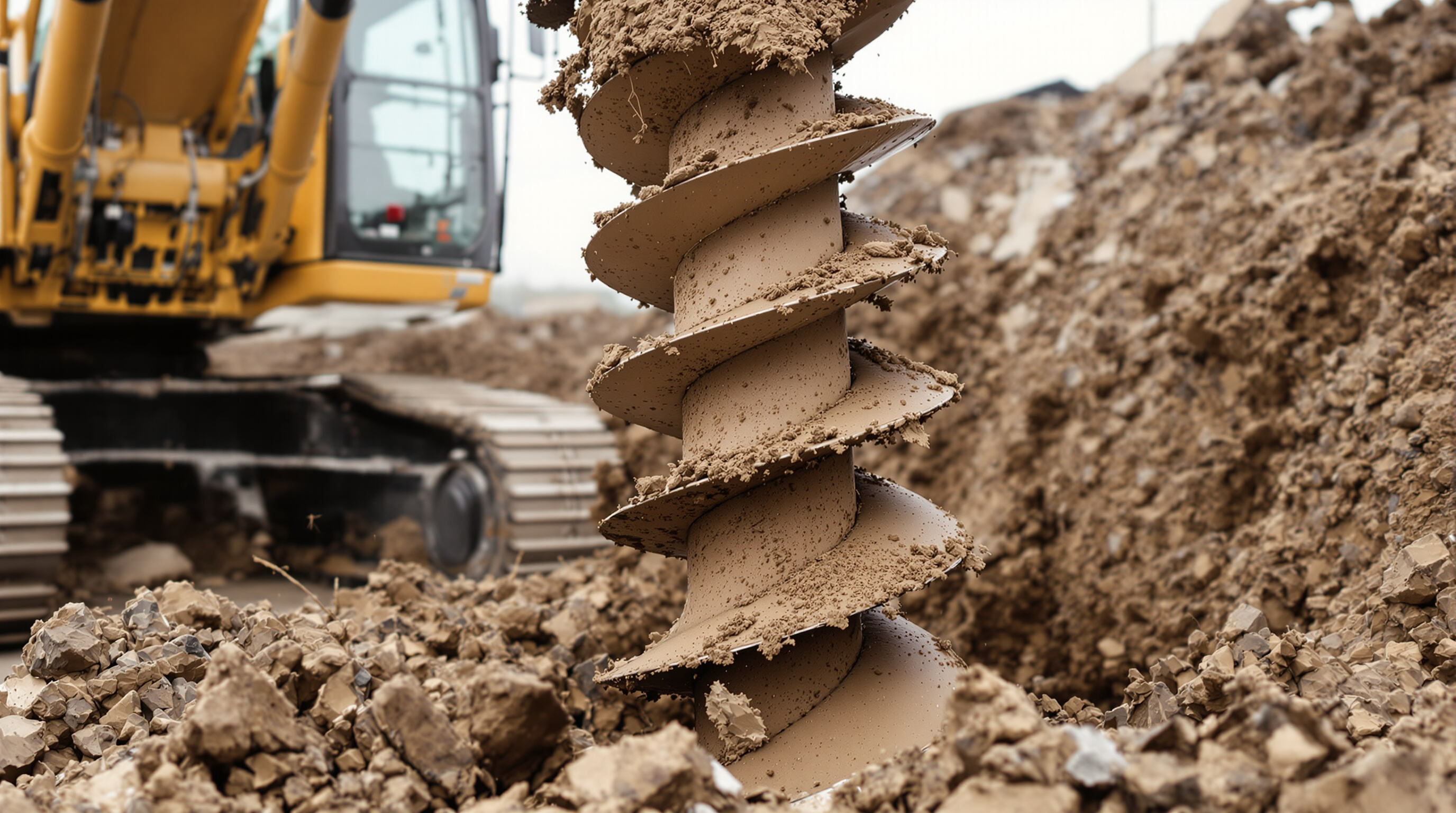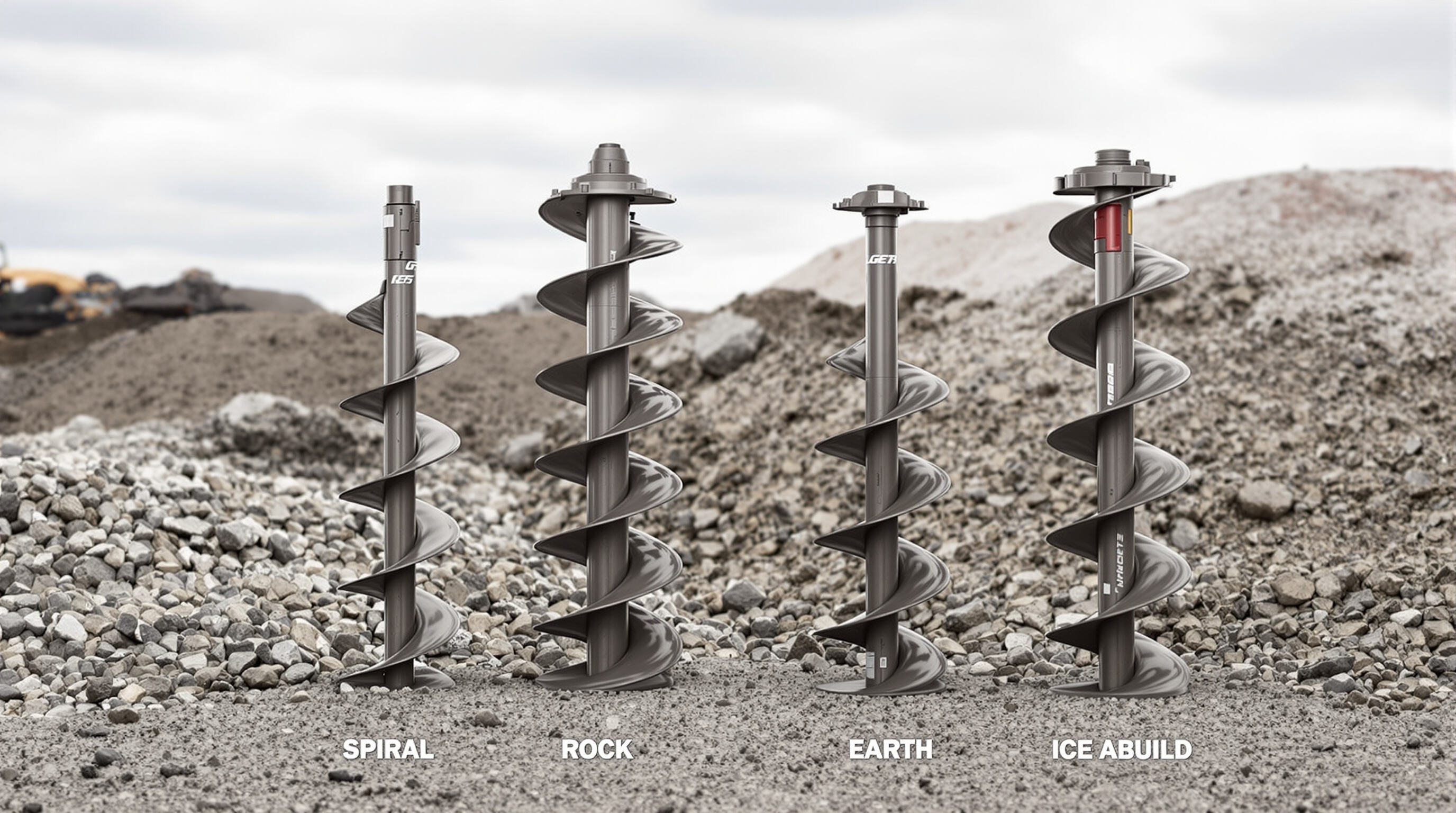What Is an Excavator Auger and How Does It Work?

Understanding Excavator Auger Attachments and Their Core Function
The excavator auger is basically a hydraulic attachment that lets operators drill really accurate holes pretty quickly no matter what kind of ground they're working on. What makes these things work so well is this spiral shaped blade that turns into the earth. When turning clockwise it drills down, but when going counterclockwise it pulls stuff back out, bringing all that dirt right up to the surface where it belongs. No more backbreaking manual digging or wasting time with buckets that just don't get the job done properly. These augers are especially good when we need uniform sized holes at specific depths, think about installing fence posts around property lines or setting trees in place during landscaping projects. Most models handle anything between roughly 4 inches wide right up to over three feet across, though actual performance depends heavily on both the size of the cutting bit used and how powerful the hydraulics happen to be.
The Role of Hydraulic Power and Rotational Force in Auger Operation
An auger works because of the excavator's hydraulic system, basically turning pressurized oil into spinning power through a motor. Most augers run between about 20 to 60 revolutions per minute, which lets them drill steadily whether they're working through soft sandy ground or really tough compacted clay. The best part about hydraulic models is their ability to adjust speed and even spin both ways, something that makes a big difference when dealing with rocks or uneven surfaces where getting stuck would be a real problem. Looking at data from the latest Hydraulic Machinery Report released in 2023, machines that can produce anywhere from five thousand to twelve thousand pound feet of torque seem to handle just about any drilling situation out there pretty well.
Hydraulic Oil Flow and Pressure Specifications for Optimal Performance
Getting good performance out of an auger really comes down to getting the right balance between hydraulic flow and pressure levels. The standard specs for most attachments fall somewhere between 15 to 25 gallons per minute (GPM) at pressures ranging from 2,000 to 3,500 PSI. Some heavier duty models actually need around 45 GPM to operate properly. When there isn't enough flow, the auger just spins slowly, which nobody wants when time matters. On the flip side, too much pressure puts unnecessary stress on all those moving parts like seals and gears inside. We've seen cases where mismatched systems cut drilling speeds down by nearly half or worse, sometimes leading to expensive component failures. Keeping things cool is another important factor. Operators should watch out for hydraulic fluid temps staying under 180 degrees Fahrenheit when running equipment for extended periods. Letting it get too hot will shorten equipment life no matter what kind of maintenance schedule is followed.
Types of Excavator Auger Attachments and Their Applications

Spiral, Rock, Earth, and Ice Auger Types: Matching Design to Terrain
Different types of excavator augers get the job done depending on what kind of dirt they're working with. Spiral augers do great in softer stuff like clay and dirt because their continuous flighting lifts all that loose material right out of the way. When dealing with rocks though, we need something tougher. Rock augers come equipped with those carbide tips and heavy duty shafts that can actually bite into granite and limestone without breaking down. Earth augers strike a nice middle ground for places where soil conditions vary from spot to spot. And let's not forget about ice augers either. These bad boys have special coatings to reduce friction plus blades designed specifically for boring through frozen ground in Arctic conditions or permafrost areas where regular equipment just won't cut it.
Common Applications in Construction, Landscaping, and Utility Work
These attachments enhance productivity across multiple industries:
- Construction: Drilling foundation piers, ground anchors, and signpost holes
- Landscaping: Planting trees, installing irrigation systems, and post-hole digging
- Utility work: Preparing pole bases and excavating trenches for pipelines and conduits
When matched to job requirements, augers can reduce project time by 30–50% compared to manual methods, according to the 2023 Equipment Efficiency Report.
How to Choose the Right Excavator Auger for Your Machine
Ensuring Compatibility With Your Excavator's Hydraulic System and Mounting Setup
Finding the correct auger begins with checking whether it works well with the excavator's hydraulic power and how it mounts. Generally speaking, most augers need between 10 and 25 gallons per minute at pressures ranging from around 2,500 to 3,500 pounds per square inch. Going beyond those numbers can actually harm the pump components or cause seal failures. On the flip side, if there isn't enough hydraulic flow coming through, the whole operation becomes inefficient and frustrating. The mounting setup matters too. Look for systems like skid-steer attachments, European style connections, or pin grabbers that fit properly with whatever quick coupler is already installed on the machine. Getting this match right ensures everything stays securely fastened during operation.
Matching Auger Drive, Flow Rate, and Pressure to Your Machine's Specifications
Align your excavator's hydraulic capabilities with the auger's requirements:
| Excavator Spec | Auger Requirement |
|---|---|
| 15 GPM flow | 12–18 GPM auger |
| 3,000 PSI | 2,800–3,200 PSI |
Mismatched systems can reduce torque by up to 40% in sandy soils and increase fuel consumption, based on 2023 field tests. For hard ground, choose augers with adjustable flow dividers to maintain consistent torque without stalling.
Quick-Connect Systems and Ease of Installation for Maximum Uptime
Modern quick-connect couplers enable attachment changes in under 90 seconds, minimizing downtime. Opt for self-aligning models with integrated safety locks to prevent accidental detachment. Regular greasing of mounting pins and hydraulic connections ensures smooth, reliable transitions between tools.
Selecting the Correct Auger Bit for Your Job Requirements
Determining hole depth, diameter, and soil conditions for proper bit sizing
Selecting the correct auger bit requires evaluating hole dimensions, soil type, and terrain hardness. Clay demands 25% more torque than sandy loam, and frozen ground requires specialized bits. Always match the bit to your excavator's hydraulic flow and pressure to avoid motor strain and ensure efficient operation.
Choosing the right bit for clay, loam, rock, or frozen ground
| Material Type | Bit Features | Performance Tips |
|---|---|---|
| Clay | Wide-spaced flights, cast teeth | Lubricate shafts hourly to prevent binding |
| Sandy Loam | Standard spiral design | Maximize RPM for faster debris removal |
| Fractured Rock | Tungsten-carbide cutters, reinforced shafts | Use pulsed drilling to reduce bit wear |
| Frozen Ground | Heated tip options, anti-vibration handles | Pre-drill pilot holes for depth accuracy |
Using terrain-specific bits improves drilling speed by 18–35% compared to generic models, according to industry data.
Achieving precision and efficiency in drilling operations
Maximize efficiency by operating within 85–95% of the excavator’s rated hydraulic pressure. Conduct tooth inspections every 50 hours to reduce unplanned downtime by 22%, as noted in the 2023 Construction Equipment Journal. For high-precision tasks like utility pole or foundation pier installation, consider laser-guided depth sensors for millimeter-level accuracy.
Maintaining Durability and Maximizing Long-Term Performance
Key Durability Features in High-Quality Excavator Auger Attachments
High-performance augers use hardened steel alloys in spiral flights and boron-carbide reinforced weld seams to resist abrasion and torsional stress. Additional features like shock-absorbing torque hubs and UV-resistant polyurethane bushings enhance reliability in extreme conditions, extending service life.
Routine Maintenance: Cleaning, Lubrication, and Wear Part Inspection
It's important to give the auger a good cleaning after every use since dirt and debris can stick around and speed up rust formation over time. For those pivot points, applying some high pressure lithium complex grease about once every two weeks keeps things running smoothly. And don't forget to check those tungsten carbide teeth at least once a month too. When they start wearing down past roughly 30% of what they originally were, it's definitely time for replacements. Industry reports from 2023 actually showed something pretty interesting - regular maintenance work cut down on unexpected breakdowns by nearly three quarters across various earth drilling operations. Makes sense really, because keeping equipment properly maintained just plain works better in the long run.
Avoiding Common Failure Points and Extending Auger Service Life
Most hydraulic system contamination actually comes from those old, worn out seals when changing bits. A simple fix? Keep those quick disconnect fittings covered with dust caps and make sure augers are stored upright on padded racks so they don't bend out of shape. When working in really cold conditions, anything below minus 40 degrees Celsius requires special attention. Heating up those auger teeth to around 150 Fahrenheit before use prevents them from cracking unexpectedly. And don't forget regular maintenance either. Check the torque on all mounting bolts every three months or so. This helps maintain structural strength after hundreds of drilling cycles, which is critical for long term equipment reliability.
FAQs
What should I consider before choosing an excavator auger?
Ensure compatibility with your excavator's hydraulic system and mounting setup, match auger drive, flow rate, and pressure to your machine’s specifications.
How do I maintain my excavator auger for long-term performance?
Routine maintenance includes cleaning, lubricating, and inspecting wear parts regularly to prevent equipment breakdown and extend its service life.
Can different auger types handle all terrains?
Yes, selecting the appropriate auger type—spiral, rock, earth, or ice—allows for efficient drilling across various soil and terrain conditions.


